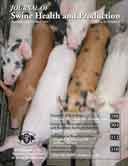Abstract:

Determining the accuracy of gestation feed drops
J. D. Schneider, PhD; M. D. Tokach, PhD; S. S. Dritz, DVM, PhD; J. L. Nelssen, PhD; J. M. DeRouchey, PhD; R. D. Goodband, PhD
PDF version is available online.
Objective: To determine the accuracy of three different types of gestation feed drops.
Materials and methods: Econo, Accu, and Ultra feed drops (Automated Production Systems, Assumption, Illinois) were attached to feed lines at three angles (90°, 75°, and 60°). Feed was collected and weighed at settings of 2, 4, 6, 8, and 10 lb (0.9, 1.8, 2.7, 3.6, and 4.65 kg) for the Econo and Accu feed drops and 2, 4, 6, and 8 lb for the Ultra feed drops.
Results: There was a drop type × angle × feed level interaction (P < .01) for the feed settings versus the actual amount dropped. At 90°, the relationship between the feeder setting (x) and actual quantity of feed dropped was best described by the regression equation (1.156x + 0.244) for the Econo, (1.010x + 0.072) for the Accu, and (1.009x + 0.231) for the Ultra feed drops. At 75°, the regression equations were (1.014x – 0.139) for the Econo, (0.997x + 0.057) for the Accu, and (1.005x + 0.156) for the Ultra feed drops. At 60°, the regression equations were (0.689x – 0.076) for the Econo, (0.989x – 0.249) for the Accu, and (0.951x + 0.026) for the Ultra feed drops.
Implications: The type of feed drop and its angle relative to the feed line influences the amount of feed dispensed at a feeder setting. The Accu and Ultra feed drops more accurately dispense the correct amount of feed than the Econo feed drops.
Keywords: feed, feed drop, gestation
![]() Cite as: Schneider JD, Tokach MD, Dritz SS. Determining the accuracy of gestation feed drops. J Swine Health Prod 2008;16(6):298-303.
Cite as: Schneider JD, Tokach MD, Dritz SS. Determining the accuracy of gestation feed drops. J Swine Health Prod 2008;16(6):298-303.
Search the AASV web site for pages with similar keywords.
